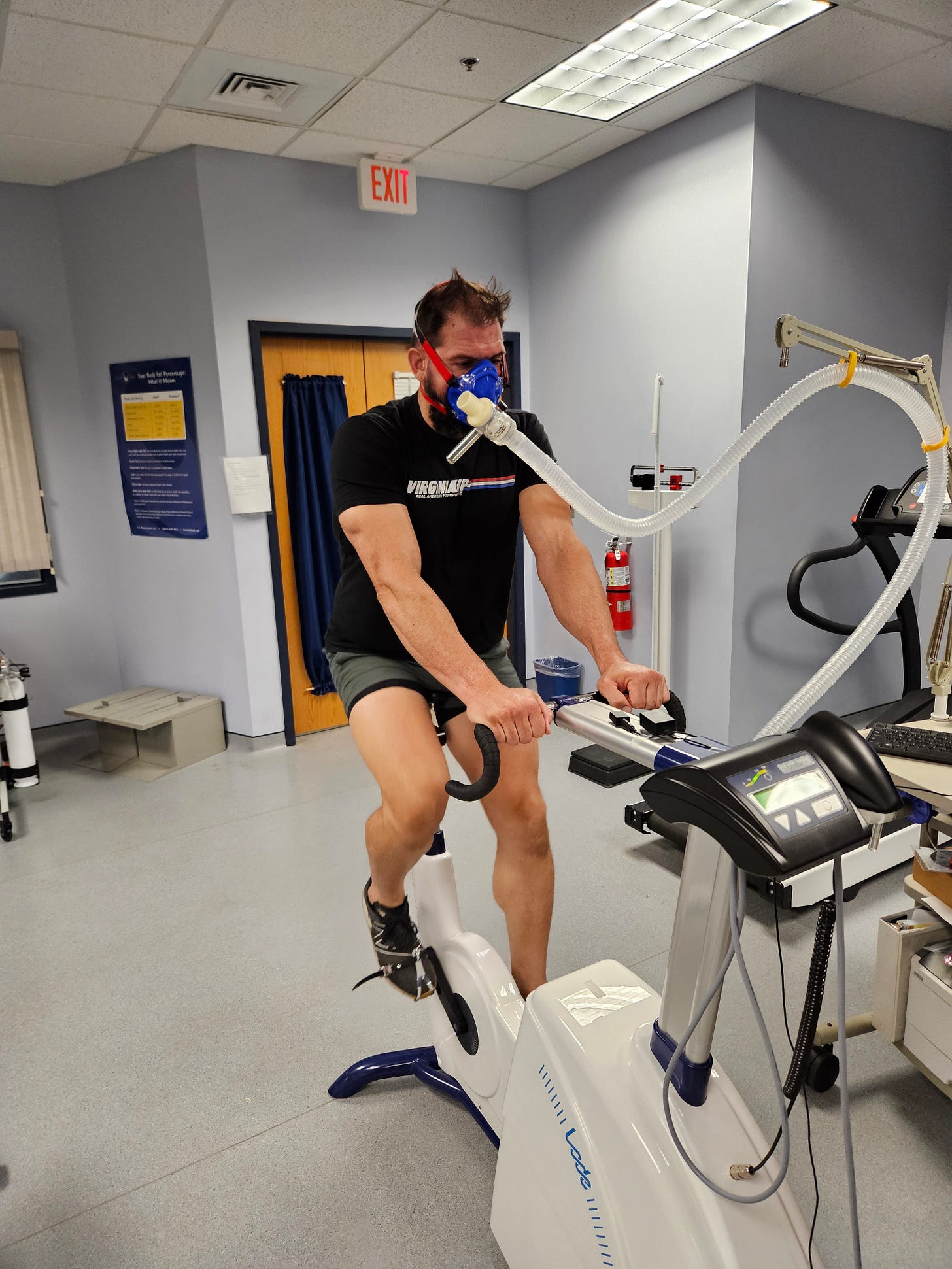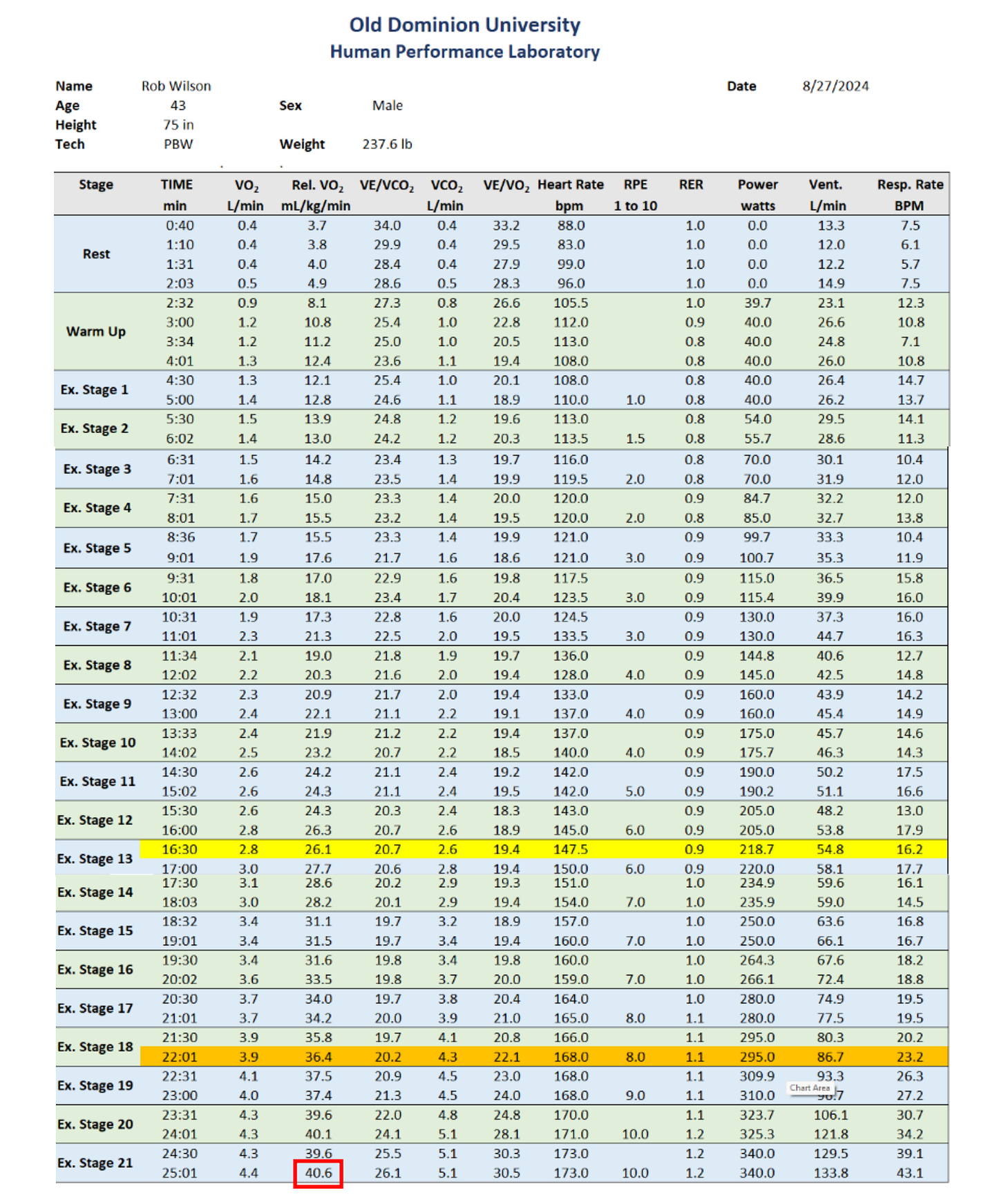Weird Science
A couple of months back I embarked on a fun little experiment with breath control and its effect on conditioning, specifically VO2max. As VO2max is getting more and more credit as a marker for longevity I went to the exercise physiology lab at Old Dominion University to get mine tested. Dr. Patrick Wilson and his graduate assistants in the lab tested me on a cycle ergometer. Which is just a fancy stationary bike in a lab that allows for computer controlled output in exercise testing. I scored "Good" on the test and was pretty happy with that considering the exercise program I'm on doesn't focus specifally on aerobic development. If you want the full scoop on the preliminary test check out THIS POST from August.
The purpose of this experiment was not only to provide myself with a baseline of fitness according to the high level of validity provided by a metabolic cart but to also see if I could make a change in this metric with a low time commitment. Usually improvements in VO2max necessitate time in Zone 2. I wanted to see if I used a breathing device three days per week for 8 weeks, if it would make a difference on the thing I was testing at this time, VO2max.
As a brief aside I want to make a larger point before we get into the experiment itself. VO2max has been scientifically validated to have a potent effect on performance and longevity. Not surprisingly as getting oxygen to your body is pretty intuitively essential. With that said, what level of investment is appropriate? How much time do I invest now for the hope of time and function in the future? If my VO2max is "Good" is it worth it to invest the two or three cumulative hours per week improving it further? How much of an effect will this have on my quality of life as the years pass? Do I want to spend the crucial currency of time sitting on a stationary bike or is their an integrative approach that could move the needle? These types of questions were driving my thinking as I approached this experiment. I'm not sure I have final answers but this article is an attempt to share how I went about things, what I learned, and where I plan on going from here.
Ad Hoc
During the course of this experiment I wanted to change as little as possible about my current training routine. My program is pretty basic. Three days per week of jiu jitsu training usually consisting of 3x10:00 live rounds. Along with that I do the Subversive Fitness Program by Wolf Brigade gym three days per week which has focused strength work followed by High Intensity Interval Training (HIIT). HIIT has been shown to rapidly improve VO2max but usually in people that had sucky scores to begin with. If you want to get past pretty okayish the data suggests more is required.
To this program I added one thing and one thing only. The use of the Breathe Way Better device made by Coach Luke Way founder of Isocapnic. The device pictured below looks kind of like an old school hot water bottle with a mouthpiece attached to it. This device is designed to exercise respiratory muscles as well as provide an isocapnic state for physiology (as the name implies). Isocapnia is a stable state between oxygen and carbon dioxide in the blood. The Breathe Way Better (BWB) device Coach Way has used this device with many Ultramarathon and triathletes to improve conditioning with great success. To read more about Isocapnic Technologies go HERE.
Rather than add or alter my current strength and conditioning regime I opted to use the BWB as an adjunct tool. In my programming there are often rest periods between intervals of work that range from thirty seconds to two minutes. Normally during these periods I would rest but during the experiment I would breathe into the BWB device. Fully inhaling to draw all of the air out of the bag and fully exhaling to fill the bag - this for the purpose of developing ventilation strength while maintaining a chemically consistent environment. Think of the old school breathe into a bag while having a panic attack (that was to stabilize CO2 BTW) except in this case rather than the body being stressed by psychology it was being stressed by physical exercise. I used the BWB during every training session for eight weeks straight.
Let me tell you something about the experience of these 24 training sessions: they sucked. In a good way. If you've never done carbon dioxide tolerance training before it's a beast unto itself. CO2 is the chemical messenger to the brain that increases the sympathetic drive to breathe faster and heavier and has also been shown to induce panic even in people with damaged amygdalae (Feinstein). As it turns out doing kettlebell swings and burpees followed by a minute or so of hard breathing into a bag will make feel like you're going to die-like for realsies. It is not only physically difficult to do but mentally it can be a demon. In the moments when your body most wants to regulate itself with fresh oxygen you give it more carbon dioxide.
My experience during the experiment, confirmed by the outcomes from the retest, was that I just got more used to things sucking. I found that even in my jiu jitsu training I was far more tolerant of fatigue and high effort. It felt like my conditioning was getting better too. But was it improving my chemistry?
VO2max Part Deux
My second time around the block with VO2max testing was an interesting one. I wasn't doing any cardiovascular or heart rate metrics during training so my only measure of potential changes in my conditioning was how I was feeling during my training. We all know how flawed perception can be so going back I was very interested to see the results.
The two pictures below are the VO2max test performed in August and October. If you look closely there is essentially zero meaningful change between the two. Max heart rate, wattage, ventilation threshold, and lactate threshold, the most were all essentially the same. At least the didn't get worse!
With that said, there was an effect I wasn't focused on but did get me thinking. The RPE scales were very different. Working at higher intensities didn't FEEL as hard as it did last time. My RPE stayed much lower for the first two thirds of the test as you can see in the spreadsheets. Again, I didn't spend any time a stationary bike getting used to this work. I breathed into a bag during normal workout intervals.
Reduced perceived exertion stands up to much of the research on ventilation training. It seems that learning to control ventilation has a primary effect on the perception of stress. In an exercise test may not doesn't seem like much of a win but in life and performance-it is. Perceiving stress differently can provide us with opportunities to access better ways of thinking, problem solving, and reflection. Not to mention perceiving stress differently can have the tangential effect of "staying in the fight" so to speak when we find ourselves at crossroads during training, sport, and life.
Improving RPE wasn't the improvement I was most focused on but it was one I was glad to have. As I mentioned earlier, I could especially feel it on the mat with my training partners and they noticed too.
Attached are the results from yesterday's test.
Overall, your VO2max was the same, and it looks like your thresholds are fairly similar to the last test, though your oxygen use and HR might have been slightly higher at your first ventilatory threshold (highlighted in yellow) this time around. That could indicate a real change, but there is of course some day-to-day variability in these thresholds, so it’s hard to completely rule that out as an explanation.
The change that appeared to be most obvious is lower perceived exertion during the first two-thirds of the test.
- Dr. Patrick Wilson, Old Dominion University
Post Hoc
What does all of this mean? That the BWB device doesn't work? Breathing techniques have no tangible outcomes in improving conditioning, specifically VO2max? Should we abandon ship, throw it all away and just put in the miles?
Not necessarily.
What we can learn from this experiment is not only what is represented in the data but a more broad way of thinking about these things in general. Here is exactly what we can divine from this experiment: my VO2max wasn't improved at my current level of fitness, by the device I used, in the exact way I used it, for the period of time in which I used it. That is it. Often when these kinds of things happen people throw the baby out with the bath water. When we do that we can miss important details that can come back and bite us in the ass later.
On thing I want to make abundantly clear here is that I did not use the BWB in the way it was intended. Coach Way has athletes use the BWB under very specific conditions to elicit adaptive responses in VO2max and lactate threshold. I wanted to use it in a different way to answer a very specific question. I may in the future do another experiment where I used it as intended and measure for myself. If I do I imagine I'll use a proxy metric like the Cooper Test max running distance in 12:00 or a timed 1.5 mile run for no other reason than paying for VO2max tests over and over again will get a bit expensive.
What does this all mean for ventilation training? Well it actually falls in line with the current research consensus. The effectiveness of ventilation training seems to be varied. Here are two randomized control trials with two different endurance populations and two different outcomes using respiratory muscle training.
One of the issues we run into when we ask about the effect of respiratory muscle training on performance is being specific about what it is we want and how we are to go about getting it. Ventilation resistance devices are not standardized so when we look at "ventilation training" we are comparing apples to oranges.
In other words there's still much work to be done.
Conclusion
As my good friend Stu Macmillan likes to say, "An individual is not the average of individuals." This means you have to test things for you. So if you want to know how a tool or program effects your fitness go test it for yourself. If it's VO2max go get it tested. Try a thing for awhile. Test it again. If you're not certain how to interpret your findings ask somebody to help.
As for me, my journey with breathing and improving health and performance is far from over. As woo-woo as it might sound, I've seen it work to many time. It's totally anecdotal and should not be taken as gospel but I've seen well conditioned athletes make improvements in health and performance through developing basic ventilation control. The questions that remain are how do we measure those things better?, and How do we standardize our approach to moving the needle?
I don't have a perfect answer to these questions but I'm here for the ride. Furthermore, I want to keep forming relationships with people like Coach Luke who are willing to put there thoughts to the test.
A special thank you to Coach Luke Way who generously provided me with a device for this experiment and provided insight and support when needed. Please check out his website isocapnic.com for more information on improving performance with breath training.
Thanks for reading,
Rob
If you dig the topics I talk about pre-order my book HERE.





